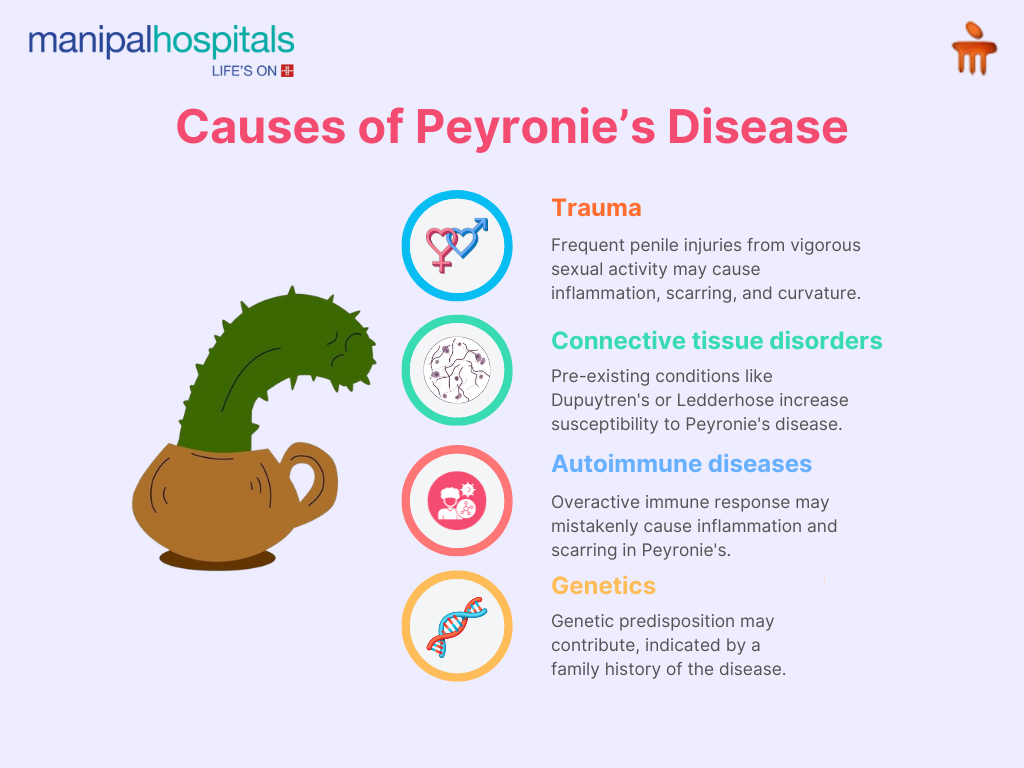
Peyronie's disease is characterised by the formation of fibrous scar tissue, called plaque, in the deeper tissues beneath the skin of the penis. The plaque accumulates inside the penis, in the tunica albuginea, a thick elastic membrane. The tunica albuginea aids in the stiffening of the penis during an erection. The plaque can form anywhere on the penis. In this article, let’s discuss Peyronie's disease symptoms, its causes, and how to manage this condition.
Synopsis
Causes of Peyronie’s Disease
The exact cause of Peyronies disorder is unknown, but several factors are believed to contribute to its development:

- Trauma: This is the most commonly suspected cause. Repeated microtears or injuries to the penis, often during vigorous sexual activity, can damage the tunica albuginea, the tough outer layer that helps maintain an erection. This damage can trigger inflammation and scar tissue formation, leading to curvature and other symptoms.
- Connective tissue disorders: Men with pre-existing conditions like Dupuytren's contracture (hand deformity) or Ledderhose disease (foot nodules) are more prone to Peyronie's disease due to underlying connective tissue abnormalities.
- Autoimmune diseases: In some cases, an overactive immune system might mistakenly attack healthy tissue in the penis, leading to inflammation and scar formation characteristic of Peyronie's disease.
- Genetics: Family history plays a role, suggesting a possible genetic predisposition to the disease.
In addition to the above factors, certain conditions like high blood sugar, tobacco use, prostate surgery, and Peyronie's disease in the partner might also contribute, though there is less conclusive evidence supporting this.
Symptoms of Peyronie’s Disease
Peyronie's disease can develop gradually, and you might not notice any symptoms in the early stages. However, as the plaque builds up in the penis, you might experience several signs that warrant a visit to your doctor. Here are some of the most common symptoms and early warning signs of Peyronie's disease:
1. Curved erection: This is the hallmark symptom of Peyronie's disease. The penis bends upwards, downwards, or to the side when erect, making sexual intercourse difficult or painful. The degree of curvature can vary, with some men experiencing only a slight bend, while others have a more pronounced deviation.
2. Lumps in the penis: You might feel one or more hard lumps under the skin of the penis, usually on the top or side. These lumps are the buildup of scar tissue (plaque) that causes the curvature.
3. Painful erections or intercourse: Pain during an erection or sexual intercourse can be another symptom of Peyronie's disease. The pain can be sharp, dull, or achy, and it might occur at the base of the penis, along the shaft, or at the tip.
4. Shortening of the penis: In some cases, Peyronie's disease can cause the penis to appear shorter when erect. This is due to the scar tissue pulling the tissue together, making the penis less flexible.
5. Difficulty maintaining an erection: Peyronie's disease can sometimes affect blood flow to the penis, making it difficult to get or maintain an erection.
6. Indentations or divots: You might notice indentations or divots on the side of the penis where the plaque has formed. These indentations can be visible even when the penis is flaccid.
7. Erectile dysfunction: While not as common, some men with Peyronie's disease might also experience erectile dysfunction, meaning they have difficulty getting or maintaining an erection firm enough for sexual intercourse.
How to Manage Peyronie’s Disease?
While there is no permanent cure for Peyronie's disease, there are several treatment options available to manage its symptoms and improve quality of life. Here are some general approaches to managing Peyronie's disease:
Medical Management:
- Oral Medications: Some medications, such as pentoxifylline and potassium para-aminobenzoate, may be prescribed to help reduce pain and slow down the progression of Peyronie's disease.
- Collagenase Clostridium Histolyticum (Xiaflex): This is an FDA-approved injectable medication that can be used to break down the collagen plaques responsible for the curvature. It is administered directly into the scar tissue by a healthcare professional.
- Physical Therapy: Penile Traction Devices: These devices apply gentle and consistent stretching to the penis, which may help reduce curvature over time. It is essential to use these devices for Peyronie's disease therapy, under the guidance of a healthcare professional.
- Vacuum Erection Devices (VEDs): VEDs may help maintain penile length and reduce curvature by improving blood flow to the area.
Surgery:
- Penile Implants: For individuals with severe Peyronie's disease and erectile dysfunction, penile implants may be considered. This surgical option involves placing inflatable or malleable rods inside the penis to provide rigidity during an erection.
- Nesbit Procedure: This surgical technique involves removing a small piece of tissue from the side opposite the plaque, which can help straighten the penis. However, it may result in a loss of penile length.
Lifestyle and Self-Care:
- Healthy Lifestyle Choices: Maintaining a healthy lifestyle with regular exercise, a balanced diet, and avoiding smoking and excessive alcohol consumption can contribute to overall well-being.
- Avoiding Trauma: Preventing additional trauma to the penis is important. Care should be taken during sexual activities to minimise stress on the affected area.
FAQ's
The exact cause is unclear, but it's linked to penile trauma, genetics, and connective tissue disorders.
Primary symptoms include penile curvature, pain during erections, palpable scar tissue, and possible erectile dysfunction.
While there's no cure, various treatments exist, including medical management, physical therapy, surgery, and lifestyle changes.
Medical treatments aim to reduce pain, slow progression, and improve curvature. Effectiveness varies, and consultation with a healthcare provider is crucial for personalised treatment.





















 3 Min Read
3 Min Read











